From Goa to the World: Paul John’s Role in the Indian Whisky Renaissance
Whisky, that noble spirit of oak and patience, has long been associated with the misty glens of Scotland and the charred barrels of Kentucky. But let’s take a detour—one with a little more heat, a touch of spice, and a rather different approach to what’s inside the bottle. Welcome to the world of Indian whisky, where tradition meets tropical intensity.
Made Differently Than Scotch & Bourbon
The first thing to understand about Indian whisky is that it doesn’t always play by the same rulebook as Scotch or Bourbon. While those bastions of whisky-making adhere to tightly controlled regulations on grain, maturation, and distillation, India has historically had a more flexible approach—one that’s evolved dramatically in recent years.
Traditionally, many Indian whiskies were crafted using molasses-based spirits, blending in malt whisky to create a smoother drinking experience. This led to some controversy internationally, as spirits derived from sugarcane are often classified as rum in other markets. While this method still accounts for a significant portion of Indian whisky production, the game has changed with the rise of grain-based single malts that stand toe-to-toe with some of the finest Scotches.
Take Paul John, for instance. This distillery uses six-row Indian barley, which has a higher protein and enzyme content than the two-row barley commonly used in Scotland. The result? A richer, slightly oilier mouthfeel with an extra dimension of spice and depth. This distinct grain profile, coupled with India’s unique climate, sets Indian whisky apart in a rather spectacular fashion.
Then there’s the question of peat. While Scotland has its peaty Islay giants, India isn’t exactly known for bog-covered landscapes. Yet, distilleries like Paul John import peat from Scotland, lending a distinctive smoky touch to their otherwise tropically influenced drams. It’s an unusual mix—the essence of a Highland winter infused with the heat of a Goan summer—but somehow, it works beautifully.


Climate & Aging – The Fast Track to Flavour
If you’ve ever wondered why a 12-year-old Scotch is often the benchmark of quality while an Indian whisky can achieve remarkable depth in just five years, the answer lies in the climate.
In Scotland, maturation is a slow, deliberate process, where the cool, damp conditions gently coax flavour from the casks over decades. In contrast, India’s intense heat and humidity push whisky into the wood at an accelerated rate, drawing out deep caramel, spice, and oak notes in a fraction of the time. But there’s a catch—this rapid aging comes at a cost.
The Angel’s Share, the portion of whisky lost to evaporation, is a modest 2-3% per year in Scotland. In India? It’s an eye-watering 8-12%. That means a whisky aged for ten years in India would be practically non-existent, which is why most Indian single malts hover in the 4-8 year range. But don’t be fooled by the number—what these whiskies lack in age statements, they make up for in sheer intensity. Think bold spices, rich tropical fruit, and deep oak integration, all wrapped up in a surprisingly smooth finish.
The barrels themselves also play a crucial role. Indian whisky is largely matured in ex-bourbon casks, which impart those classic vanilla, caramel, and toasty wood notes. Some distilleries experiment with sherry, wine, or even indigenous woods, but the rapid extraction of flavour from American oak tends to be the defining characteristic of Indian whisky.

Whisky Consumption in India
India’s relationship with whisky is both profound and expansive. The country stands as one of the largest consumers of whisky globally, with the spirit holding a significant share of the alcoholic beverage market. This affinity spans across various demographics, from urban professionals to rural communities, making whisky a ubiquitous presence at social gatherings, celebrations, and everyday life.
While specific consumption statistics can vary, it’s evident that whisky dominates the Indian spirits landscape. The preference leans towards locally produced whiskies, which are often more affordable and cater to regional tastes. However, there’s a growing segment of consumers gravitating towards premium and imported brands, reflecting a shift in aspirations and disposable incomes.
Other Popular Spirits in India
Beyond whisky, India’s spirits market is rich and diverse:
- Rum: Traditionally popular, with some brands enjoying a cult status among enthusiasts.
- Brandy: Particularly favoured in southern states, brandy has a strong consumer base.
- Vodka: Gaining traction among younger demographics, especially in urban areas.
- Traditional Spirits: Indigenous beverages like Mahua, made from the flowers of the Madhuca longifolia tree, hold cultural significance and are consumed in various regions.
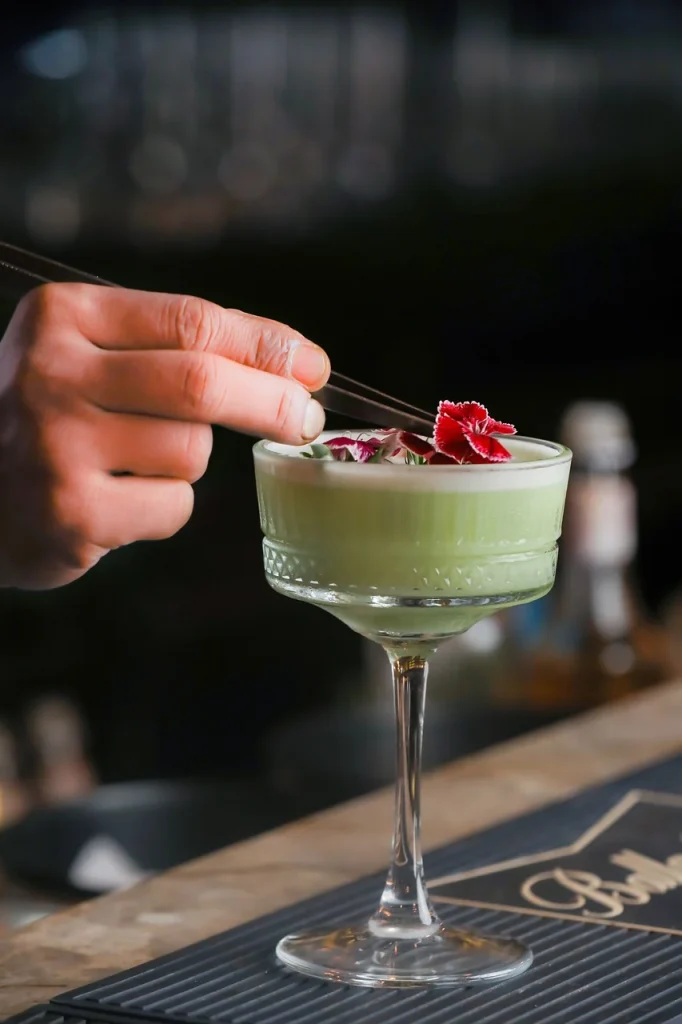
Cultural, Business, and Global Recognition
Indian whisky’s journey is emblematic of a broader narrative—one that doesn’t always play by the traditional rulebook but carves its own path through innovation and resilience.
Culturally, whisky has transcended its colonial origins to become an integral part of Indian society. It’s not just a drink but a symbol of camaraderie, celebration, and status. This cultural integration has paved the way for domestic producers to flourish, adapting to local palates while maintaining global standards.
From a business perspective, Indian distilleries have showcased remarkable adaptability. By embracing traditional methods alongside modern techniques, they’ve crafted products that resonate both locally and internationally. The emphasis on quality, coupled with strategic branding, has positioned Indian whisky on the global stage.
The international acclaim for Indian whisky is no accident. Producers have actively participated in global spirit competitions, earning accolades that challenge long-held perceptions. Collaborations with international experts and adherence to stringent quality controls have further solidified their reputation.
Moreover, the unique climatic conditions of India, which accelerate the aging process, have been leveraged as a distinct advantage. This rapid maturation imparts rich flavours in a shorter time, offering a unique selling proposition in the global market.


A Case in Point
Paul John exemplifies this spirit of innovation and excellence. By focusing on indigenous ingredients and embracing the nuances of the Indian climate, they’ve crafted whiskies that stand out in a crowded market. Their commitment to quality and authenticity has not only garnered domestic appreciation but also international accolades.
India’s Golden Drop of Liquid Sunshine
Indian whisky has been on a meteoric rise, with distilleries proving that world-class craftsmanship isn’t limited to the misty glens of Scotland. Among the finest in the game is Paul John Whisky, a name synonymous with quality, innovation, and tropical elegance. Hailing from the sun-drenched shores of Goa, Paul John has carved out a place in the premium whisky sphere, offering expressions that balance the exotic warmth of India’s climate with meticulous distillation techniques.
The Full Line-Up
The core and limited expressions cover a broad spectrum of palates, from light and floral to dark and peaty. Their current range includes:
- Nirvana
- Brilliance
- Edited
- Bold
- Classic Select Cask
- Peated Select Cask
- Christmas Editions (annual releases)
- Oloroso Select Cask
- Pedro Ximénez Select Cask
- Mars Orbiter Limited Edition
Each bottle reflects Goa’s unique tropical maturation process, which speeds up ageing while intensifying flavours, a phenomenon often called the ‘Angel’s Share on steroids.’ But today, we’re zoning in on five stellar expressions—Bold, Brilliance, Classic Select Cask, Nirvana, and Oloroso Select Cask—to see what sets them apart and why they deserve a place in your cabinet.

Bold – The Smoky Rebel
Process & Characteristics: Bold is the peated warrior, proving that India can do smoky whisky just as well as the Scots. It uses imported Scottish peat but leverages the warm Goan climate to craft an expression that is robust yet surprisingly elegant. The peat influence is significant but well-integrated, achieved through a mix of traditional pot-still distillation and careful cask maturation.
- Colour: Rich amber with golden glints.
- Nose: A commanding presence of earthy peat, mingled with toasted oak, warm spices, and a delicate hint of vanilla.
- Palate: Smoky intensity upfront, unfolding into dark chocolate, honey, and dried fruit, underpinned by soft spice and malt sweetness.
- Finish: Long and satisfying, with lingering smoke and a touch of peppered caramel.
Perfect for those who love Islay-style drams but want a tropical twist.
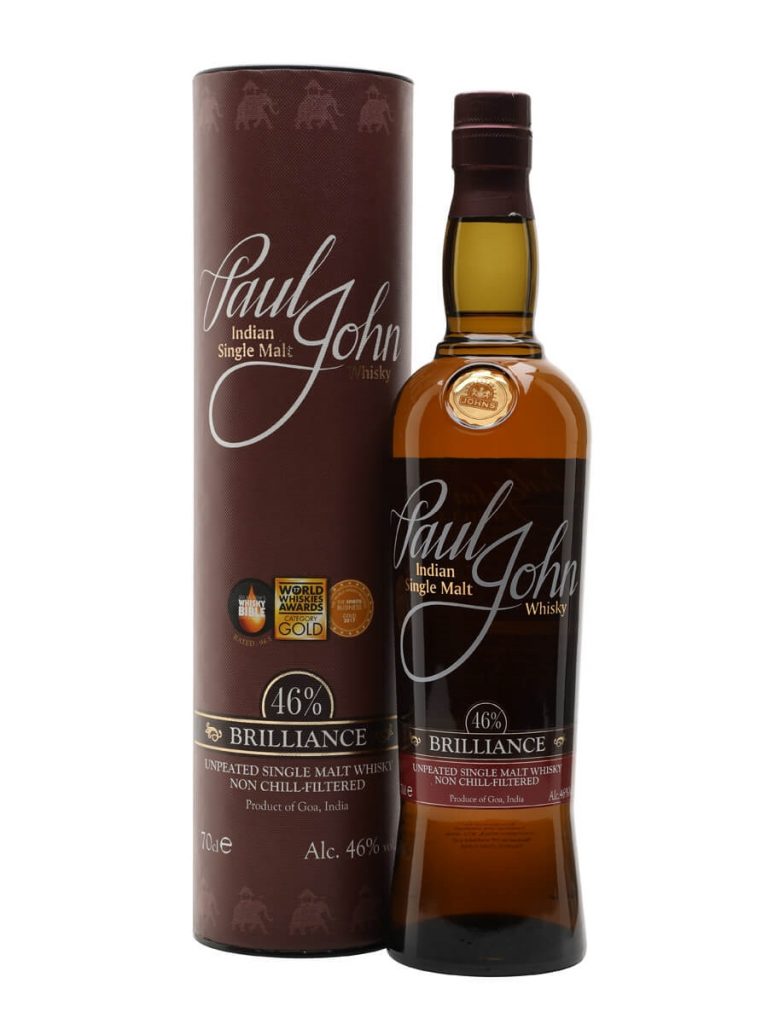
Brilliance – The Unpeated Gem
Process & Characteristics: Brilliance is crafted using six-row barley grown in the foothills of the Himalayas, giving it a higher protein content and deeper malt character. It’s completely unpeated, allowing the natural vibrancy of the grains and ex-bourbon cask maturation to shine through.
- Colour: Sunlit gold.
- Nose: A honeyed bouquet of vanilla, citrus, and warm malt, with a whisper of toasted nuts.
- Palate: Buttery toffee and orchard fruits lead the way, followed by soft oak and a teasing note of cinnamon and cardamom.
- Finish: Medium length, with a gentle wave of spice and caramel sweetness.
A perfect starting point for those new to Paul John or unpeated whisky in general.
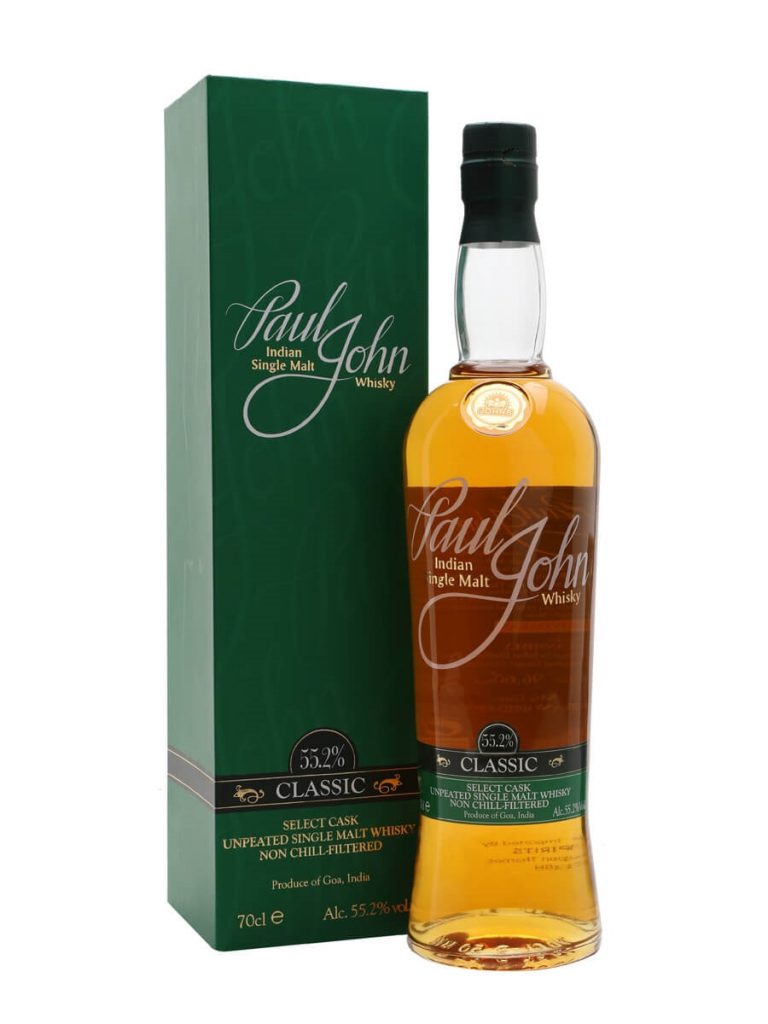
Classic Select Cask – The Balanced Masterpiece
Process & Characteristics: A higher ABV (55.2%) expression, Classic Select Cask is matured in ex-bourbon barrels, allowing the tropical climate to enhance its complexity. It’s unpeated but carries an undeniable depth and intensity.
- Colour: Deep gold with hints of copper.
- Nose: Honey-drenched oak, dried fruit, vanilla pods, and a touch of coconut.
- Palate: Rich and creamy, with caramelised sugar, juicy mango, and spice-laden oak.
- Finish: Long, warm, and complex, with vanilla and wood spice taking centre stage.
This is a whisky that demands slow sipping, rewarding you with layers of flavour in every drop.
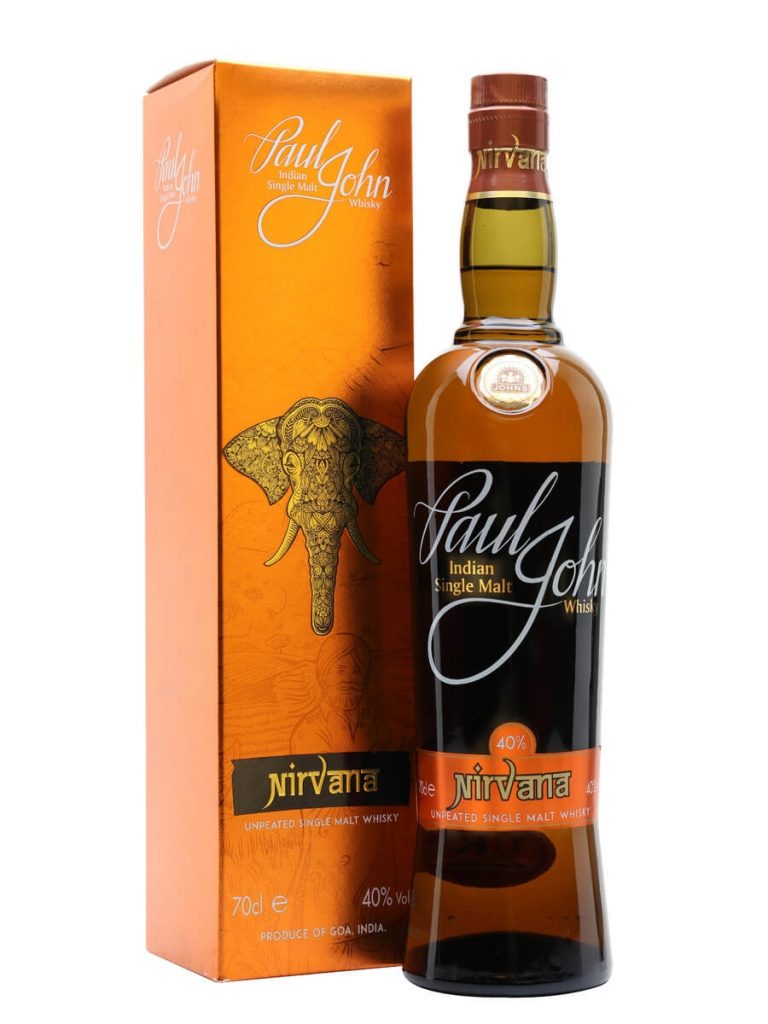
Nirvana – The Gateway to Indian Whisky
Process & Characteristics: Nirvana is designed as an approachable, entry-level whisky, yet it doesn’t compromise on character. Matured in bourbon casks, it offers a welcoming, fruit-forward profile.
- Colour: Golden straw.
- Nose: Bursting with honey, toasted oak, and tropical fruit (think bananas and pineapple).
- Palate: Light-bodied yet flavourful, with caramel, vanilla, and gentle spice dancing on the tongue.
- Finish: Crisp and refreshing, with a soft malt sweetness.
A great everyday dram or an introduction to the range for newcomers.
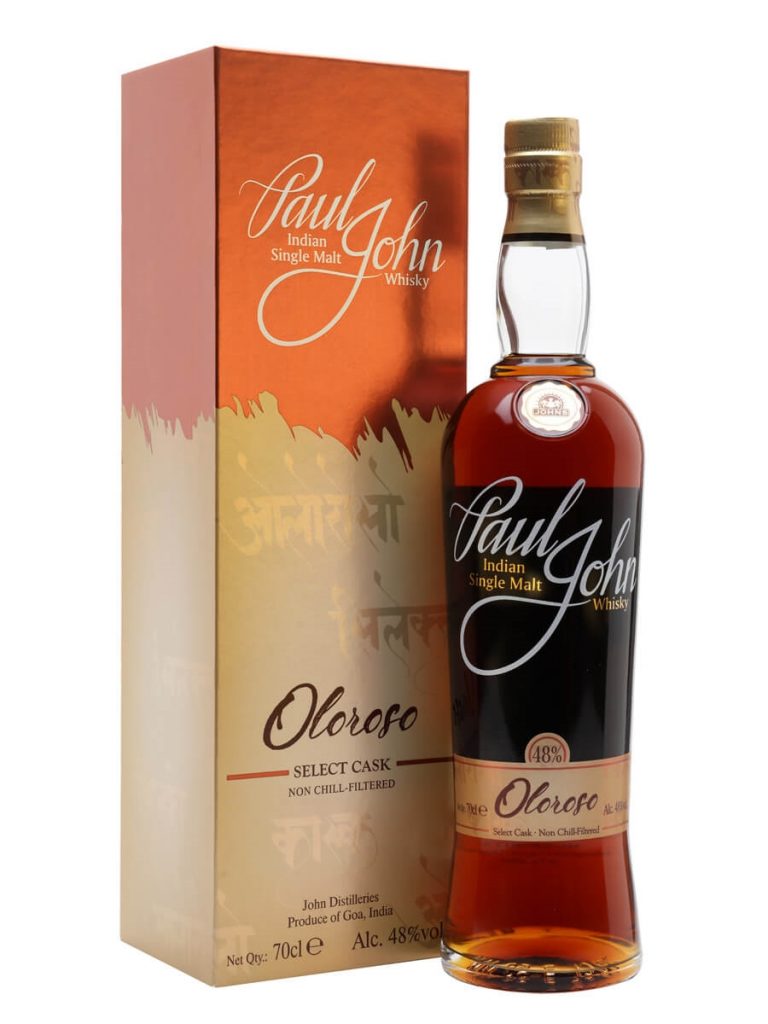
Oloroso Select Cask – Sherry-Lover’s Dream
Process & Characteristics: Matured in Oloroso sherry casks, this is the distiller’s rich and indulgent expression. The sherry cask influence imparts a deep, luscious sweetness, balancing out the tropical ageing effects.
- Colour: Deep mahogany.
- Nose: Decadent dark chocolate, dried figs, and stewed plums, wrapped in an embrace of toasted nuts.
- Palate: Luxuriously smooth, with layers of caramelised raisins, spiced oak, and a kiss of coffee.
- Finish: Long and sherried, with an elegant fusion of dark fruit and nutty warmth.
A must-try for sherry cask aficionados looking for something a little different from traditional European whiskies.






The Paul John Experience – A Whisky Pilgrimage
For those who want to experience Indian whisky at its source, a visit to the Paul John Visitor Centre in Goa is a must. Nestled in lush tropical surroundings, the distillery offers an immersive journey through the whisky-making process, from barley selection to cask maturation.
Guided tours provide a behind-the-scenes look at traditional copper pot stills, the meticulous aging process, and the influence of Goa’s climate on whisky development. And, of course, there’s the all-important tasting session—where visitors can sample Paul John’s finest expressions, each offering a distinct glimpse into India’s whisky craftsmanship.
The experience isn’t just about tasting whisky; it’s about understanding the passion, science, and artistry behind every bottle. For whisky lovers, this is more than a tour—it’s a deep dive into a spirit that’s rewriting global whisky norms.


The Future of Indian Whisky
Paul John isn’t just making great Indian whisky—it’s redefining what whisky can be. The combination of Himalayan barley, tropical maturation, and expert cask management creates expressions that are complex, vibrant, and deeply rewarding. Whether you’re a fan of smoky drams, sweet and malty profiles, or rich sherry finishes, there’s a Paul John whisky with your name on it. The only real challenge? Deciding which one to pour first.
But beyond just Paul John, Indian whisky as a whole is stepping onto the world stage with confidence. Gone are the days of being seen as an outlier—these whiskies are earning respect, winning awards, and challenging preconceptions. The industry’s ability to harness its unique climate, experiment with techniques, and push past old definitions has led to a category that is no longer a curiosity but a contender.
So, the next time you pour a dram, consider reaching for something with a little more heat, a little more spice, and a whole lot of character. Indian whisky isn’t just made differently—it’s rewriting the whisky rulebook.
Further information: https://pauljohnwhisky.com/
All materials are reproduced in good faith and remain the copyright of their respective owners. ©Luxfanzine, 2025




